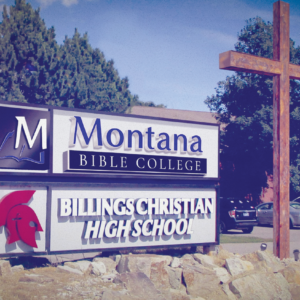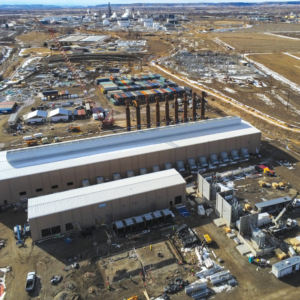Quietly growing and succeeding, step by step, in the education world, in Billings is the Billings Christian School (BCS) at 4519 Grand Avenue. And this fall it took another giant leap forward with the addition of Montana Bible College (MBC) which has moved to 1519 S. Shiloh Road, Billings, from Bozeman.
The addition of the college follows last year’s addition of a new high school on Shiloh Road.
Billings Christian School was launched in 1981 with 42 students. Today its K-12 enrollment is 400, and growing.
It was a long –term goal of the school to one day add a college, but amazingly that day came much, much sooner than anticipated, explained Matthew McDonnell, President of the Billings Christian School Foundation.
Montana Bible College was finding it more and more difficult to remain in Bozeman because of the increasing cost of living and doing business there. Through mutual acquaintances, the two education centers began discussing the possibility of the college moving to Billings and sharing the same campus with the Billings Christian High School. This fall marks the beginning of the college’s first classes with a 52 student enrollment.
Ryan Ward is President of MBC, which hopes to soon have over a hundred student enrollment. McDonnell has no doubt that they will achieve that goal because “they do such a great job with staffing and being self-sustained.”
McDonnell is thoroughly pleased with what the college brings to BCS. Its proximity offers inspiration and encouragement to high school students on a daily basis, as well as an opportunity to fast track their education through high school classes that offer dual credits.
While the college is located on the same campus as the high school, the college students are being housed elsewhere while dorms are being built for next year’s students.
The real amazement is that the MBC addition follows so closely on the heels of BCS getting a high school, which in itself was a remarkable development. Faced with rapid growth, BCS Board members knew they had to expand their high school but it loomed as quite a daunting challenge.
When Yellowstone Bible College moved from their location on Shiloh Road, suddenly there sat a magnificent facility just waiting to be used. The problem was, because of its prime location, the 11 acres with three buildings and a chapel, was worth more without “all this stuff on it.” But then something of a miracle happened, a donor stepped in and bought the property, making it available to the school for the next five years for $1 a year, with the goal that the school would be able to purchase it in five years.
“We did it in two,” said McDonnell, crediting the hard work of many people and the generosity of “parents and grandparents,” and the success of getting the school functioning on a business-like basis.
On every front, McDonnell is enthusiastic about what is happening at BCS. He says he wished he could have attended a school like BCS. He and his wife discovered BCS when they started investigating education options for their children. After becoming involved with BCS, it wasn’t long before McDonnell’s enthusiasm netted him the position as President of the school’s foundation which was established in 2005.
Under the direction of Dan Makowski, BCS serves some 40 different church denominations. It functions as a tax exempt corporation governed by an independent Board of Directors.
Why has the school continued to grow? “Because of the quality of our teachers and the value of a Christian education,” said McDonnell. “Parents began to see that kids have a different value set with a Christian education.”. . . and the school offers “more of a family setting” Parents are very much involved with the school on a daily basis.
Also, COVID played a significant role.
It seemed that the school was just getting its footing, explained McDonnell, when “the world shut down” because of COVID. The situation generated considerable concern that the school might not recover from the same setbacks that so many businesses and enterprises were confronting. But it turned out that just the opposite happened.
“COVID really showed the public some of the stuff that was happening in public schools. It unveiled that society was more morally bankrupt than they had realized, and that pushed many people to consider a Christian education.” They started looking at private schools and home schooling options.
Suddenly, Billings Christian School was enrolled to capacity and had “a huge waiting list.” The waiting list could have been even bigger than it was, said McDonnell, because when some people found out how long it was they didn’t even ask to be put on it.
At the beginning of COVID the school had 275 students enrolled, now they have over 400, with others on the waiting list.
Anticipating further growth, Billings Christian School is currently focused on raising $2 million to help in adding a state-of –the art gymnasium and to upgrade their science and art rooms, the administration offices and to add four more classrooms. The over-all cost for all the additions is estimated at about $6 million.
It’s a daunting challenge but McDonnell is optimistic because of what the school has to offer families and belief it is what many are seeking. “We have to really focus on growing,” said McDonnell.
There is no pulling punches about Billings Christian School being a Christian school. It’s a firm stance that prohibits the school from getting any public funds, even though the parents are taxpaying citizens – and it disqualifies them for some grants. There have been instances in which they were encouraged to minimize their emphasize on teaching religion, but those “opportunities” have been flatly refused, said McDonnell.
The school is dually credited through the Association of Christian Schools International (ACSI) and COGNIA.
It is a member of the National Christian School Athletic Association – and in fact the school’s basketball team, The Warriors, won the national championship last year.
Offered in the high school are courses on Bible, English, mathematics, history, science, Spanish, fine arts, choir, orchestra, band, physical education and electives such as business, Christian Leadership, computer coding, robotics, STEM, home economics, elementary, aide, Financial Peace University, speech, debate, drama, yearbook, logic, internships and independent studies.
Montana Bible College, founded in 1987, is accredited by the Association for Biblical Higher Education Commission and the Evangelical Council for Financial Accountability.
MBC strives to make sure their students graduate debt free. And, though MBC is eligible for Federal Title IV funding, they have chosen not to participate. “We wish to remain free from dependence on the government and free from the “strings” attached to government money,” states their website.
Besides a a Bachelor of Arts in Biblical Studies with five emphasis, students may obtain degrees in business administration, communications, criminal justice, healthcare management, marketing and sports management.


